MINING & EXPORTS
An Overview

The Group has under its control a total mining area of 264 hectares in Goa. The Pale group of Mines which consists of Jaquela Ou Jacadevicho Mollo Mines of M/s. Bandekar Brothers Pvt. Ltd., and Madachem Bat Mines of M/s. Madachem Bat Mines Pvt. Ltd., form the major mining areas.
All these Mines put together produce about one million tons per annum of different grades depending upon the sale commitments. The Group is professionally managed and has a pool of High Powered Executives, Administrators, Operations & Project Management Team, Cost Accountants, Mining Engineers, Technicians and Personnel Managers who have been contributing to the high reputation of the Group.
Pale Group of Mines

These Mines popularly known as "PALE GROUP OF MINES" are located in the Southern part of Northern Goa which is on the West Coast of India. The Mines are 45 kms away from the Port of Mormugao. These Mines cover an area of about 164 hectares. The operations of the Mines are managed by a team of experienced, technical and administrative professionals. The Mines are fully mechanised and are well equipped with modern infrastructural site facilities. Mining is being carried out by open cast Mining methods. The Mines are fully mechanized using heavy Earthmoving Machinery such as Excavators, Ripper Dozers, Tipper Dumpers, Wheel Loaders, Dewatering Pumps, etc. The Ore is transported to the Processing Plants and Loading Jetties using Trucks and Tipper Dumpers.
Processing Plants

Processing Plant

Iron Ore passes through Classifiers
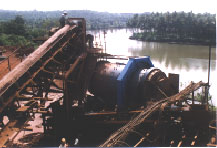
The Blue colour equipment is a Scrubber

Screening of Iron Ore on Vibrating
Screening Plan
The Ore gets transported by road from the Mines to the Processing Plants located at Kotumbi Loading Jetty, which is around 7 kms away. The Ore is processed using State of The Art processing plants by dry screening, as well as the Beneficiation Plant which consists of a Crusher, Scrubber, Screens, Classifiers, Hydrocyclones, Pumps, etc.
Quality Control

Full View of Iron Ore Stacks
The quality control which is given utmost importance starts from the stage of prospecting. A full fledged modern and well equipped Laboratory is located at the Kotumbi Loading Jetty. The Laboratory is manned by a very Senior Chemist assisted by a team of Junior Chemists. Various elements are analysed in the Laboratory at every stage of prospecting, mining, stacking of crude ore, feed to plants, stacking of processed ore, loading into the barges, etc. Besides our in house quality checks, we many a times depute professionally managed independent Assayers who are professionally accredited to check our quality. The final product is then analyzed before dispatch. All our products bear a stamp of Quality.
Loading Jetties
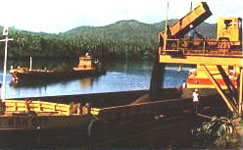
Barge being loaded at Kotumbi Jetty
The Loading Jetties are located at Kotumbi, with round the clock operations and round the year facilities for loading of the barges. Barges with capacities as high as 2500 Tons can be loaded on these Jetties. The area at the Loading Jetties can stack about 5 Million Tons of Ore.
Safety Awareness
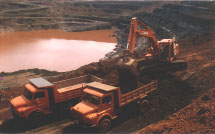
Mining Operations
Safety is of paramount importance to the RNSB Group. No worker is allowed in working areas with appropriate footwear, head gear, etc. So also, no machinery or trucks are allowed in the working areas without conforming to safety standards laid down by us. Every truck that moves in and out of RNSB’s working areas are adequately covered to minimize pollution as well as increase road safety during transit. We strive to conduct our mining operations safely, by regularly monitoring our safety procedures. Right from Exploration, Mining, Use of Heavy Machinery, Transport, Processing Plants, Loading Jetties, etc, our people constantly set bench marks to attain World standards.
GOA PORTS
There are two operational Ports in Goa for the Export of Iron Ore, namely Mormugao Port (Major Port) and Panjim Port (Minor Port). The Ore is transported to these Ports through self propelled barges from the various Loading Jetties, for onward shipment.
Mormugao Port
The Mormugao Port has three types of loading facilities.
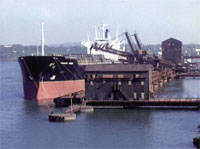
Berth No. 9 Loading
1) Berth No. 9: Modern Mechanical Ore Handling Plant at Berth No.9 with a loading capacity of 40,000 tons per day. Vessels with gears of minimum 30000 DWT and gearless Vessels with minimum 25000 DWT are only accepted for loading at this Berth No. 9.
Draft from June to Sept. 11.0 mts.
And from Oct. to May. 13.0 mts.
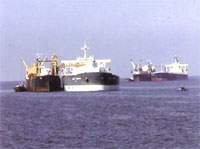
Transhipper Vessels
2) Transhipper Vessels: Cape size Vessels which are partly loaded at Berth No.9 up to maximum Draft of 12.3 mtrs, can be uptopped at outer harbour with the use of Transhipper Vessels. There are a number of private Transhipper Vessels operating at this Port. The loading rate by transhipper vessel is 10,000 to 30,000 tons per WWD depending on the transhipper and weather conditions.
3) Loading By Geared Vessels: Midstream loading by using Vessel's own Gears, Cranes and Grabs is used for loading Iron Ore in mid stream at the Mooring Dolphins at inner anchorage at this port, with draft res]tractions upto 12.5 metres.
Panjim Port
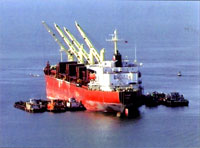
Panjim Port Loading
This is a Minor Port, situated North of Mormugao Port, where Vessels of any size without Draft restrictions can be loaded by using Vessel's own Grabs or by Transhipper Vessels. There are a number of Transhippers Vessels operating in Panjim Port. There are no other loading facilities at this Port.
